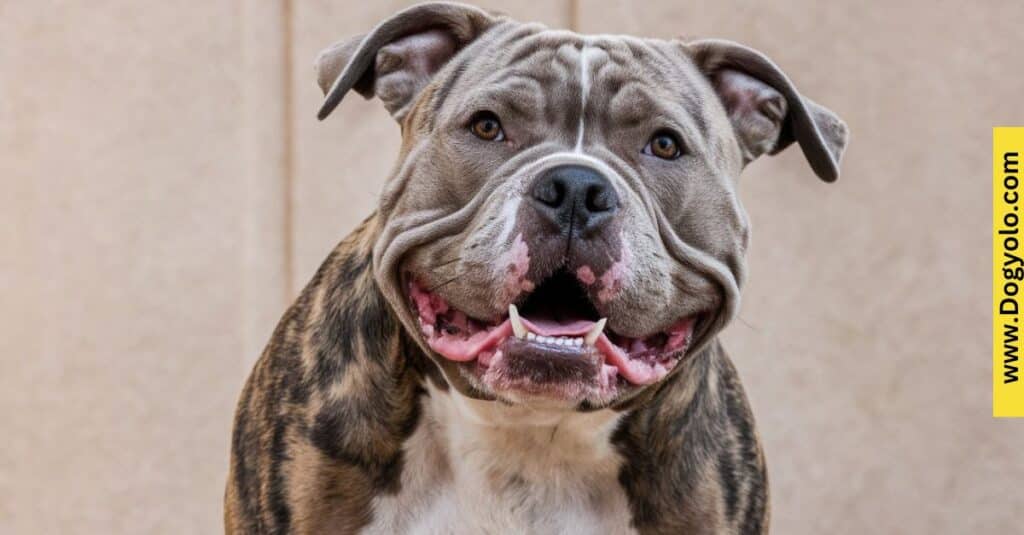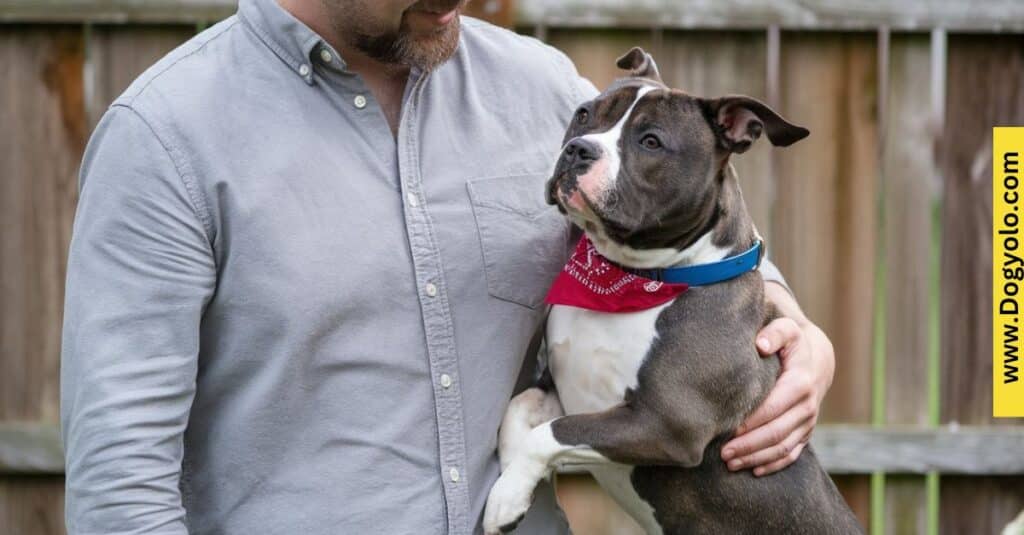Meet the Pocket Bully, the smallest variant of the American Bully Dog, renowned for its muscular build and compact size. This popular breed offers a perfect balance for those seeking a sturdy yet manageable dog.
In this blog, we explore the Pocket Bully’s history, appearance, temperament, and health, providing essential insights for potential owners and dog enthusiasts.
Pocket Bully Breed Overview

What Is a Pocket Bully?
The Amrican Pocket Bully is a type of American Bull Dog, specifically bred to be smaller than its standard counterparts. Despite its size, this breed maintains the muscular, stocky build and confident demeanor that American Bullies are known for.
The American Bully was initially developed in the United States, and the Pocket Bully is one of the four recognized sizes within the breed standard, with the others being Standard, Classic, and XL.
Read more about 13 Cane Corso Colors
Characteristics of the american Pocket Bully
| Trait | Description |
| Size | 13-17 inches (33-43 cm) at the shoulder |
| Weight | 30-50 pounds (13.6-22.7 kg) |
| Coat | Short, smooth, and glossy |
| Lifespan | 10-12 years |
| Temperament | Loyal, affectionate, protective |
| Exercise Needs | Moderate; daily walks and playtime |
| Grooming Needs | Low; regular brushing and occasional baths |
History of the Pocket Bullies

Origins of the Pocket Bullies
The Pocket Bullies were developed in the 1990s as breeders aimed to create a smaller version of the American Bully that retained the breed’s signature muscularity and athleticism. By selectively breeding smaller American Bullies with similar traits, the Pocket Bullies were born.
The Rise in Popularity
As dog enthusiasts began to appreciate the Pocket Bully’s compact size and formidable appearance, the breed’s popularity soared.
This miniature bully became especially favored by those living in urban environments who wanted a muscular dog without the challenges of a larger breed.
Breeding Practices and Standards
Breeding a Pocket Bully requires a thorough understanding of breeding practices to ensure the health and quality of the puppies.
Ethical breeders prioritize health, temperament, and adherence to breed standards, which is crucial given the breed’s relatively short history.
Is the Pocket Bully a Registered Dog Breed?
Recognition by Kennel Clubs
The American Pocket Bully is recognized by several breed registries, most notably the American Bully Kennel Club (ABKC). This organization sets the breed standards for the Pocket Bully, ensuring consistency in appearance and temperament.
However, it’s important to note that the breed is not recognized by larger, more traditional registries like the American Kennel Club (AKC).
Breed Standards
The ABKC specifies that this dog should not exceed 17 inches in height at the shoulder. This size distinction is what sets the Pocket Bull Dog apart from other types of American Bullies.
The breed standard also emphasizes a compact, muscular build, a broad chest, and a confident stance.
Appearance
Physical Characteristics
The Pocket Bull Dog is known for its muscular build, which is both compact and powerful. Its head is broad with a pronounced cheek structure, and the ears may be natural or cropped.
The breed’s eyes are typically round and set low on the skull, giving the dog an alert and determined expression.

Coat and Color Variations
Pocket Bullies have a short, smooth coat that requires minimal grooming. Their coats can come in a wide range of colors, including:
- Solid Colors: Black, blue, fawn, chocolate
- Brindle Patterns: A mixture of lighter and darker stripes
- Tri-color Combinations: Typically black, tan, and white
These coat variations add to the breed’s appeal, offering a unique appearance for each dog.
Pocket Bully Size
Size Specifications
The Pocket Bull Dog stands between 13 to 17 inches tall at the shoulder and weighs between 30 to 50 pounds. Despite its smaller size, this breed retains the muscular build that characterizes the American Bully.
The compact size of the Pocket Bull Dog makes it an ideal choice for those who want a strong, robust dog without the challenges of managing a larger breed.
Comparison to Other American Bullies
| Bully Type | Height Range | Weight Range |
| Pocket Bully | 13-17 inches (33-43 cm) | 30-50 pounds (13.6-22.7 kg) |
| Standard Bully | 17-20 inches (43-51 cm) | 50-70 pounds (22.7-31.8 kg) |
| Classic Bully | 17-20 inches (43-51 cm) | 50-70 pounds (22.7-31.8 kg) |
| XL Bully | 20-23 inches (51-58 cm) | 70-120 pounds (31.8-54.4 kg) |
The Pocket Bull Dog is the smallest in the American Bully family, making it a popular choice for those seeking a more manageable size.
Temperament
Personality Traits
Pocket Bullies are known for their loyal, affectionate, and protective nature. They are typically very attached to their families and thrive on companionship.
Despite their muscular and intimidating appearance, Pocket Bullies are gentle and loving, especially when properly socialized from a young age.
Social Behavior
As social dogs, Pocket Bullies enjoy interacting with people and other animals. They are generally friendly and outgoing, though their protective instincts may lead them to be wary of strangers.
Early socialization is crucial to ensure that these dogs develop into well-adjusted adults.
Energy Levels
Pocket Bullies have moderate energy levels, making them well-suited for various living environments, from apartments to houses with yards.
They require regular exercise to stay healthy and happy, but they are also content to relax with their owners after a good play session.
Are Pocket Bullies Aggressive?
Common Misconceptions
One of the biggest misconceptions about the Pocket Bull Dog is that they are inherently aggressive due to their muscular build and lineage from Pit Bulls.
However, Pocket Bullies temperament is typically gentle and affectionate, especially towards their family members. Aggression is not a common trait in well-bred and well-socialized Pocket Bullies.
Behavioral Tendencies
While Pocket Bullies can be protective, especially of their families, this should not be confused with aggression.
Proper training and socialization play a significant role in shaping a Pocket Bully’s behavior. When raised in a loving environment with consistent training, these dogs are usually calm and friendly.
Is the Pocket Bull Dog a Good Family Dog?

Family Compatibility
Pocket Bullies make excellent family pets due to their loyal and affectionate nature. They are deeply devoted to their families and are known to form strong bonds with children.
Their protective instincts also make them good watchdogs, alerting their families to any potential threats.
Interaction with Children
Pocket Bullies are generally good with children, especially when they are raised together. Their sturdy build makes them less fragile around energetic kids, and their gentle demeanor ensures that they are patient and tolerant.
However, it’s always important to supervise interactions between dogs and young children to prevent any accidental harm.
Adaptability
One of the key strengths of the Pocket Bully is its adaptability. Whether you live in a large house or a small apartment, this dog can thrive as long as it receives enough exercise and mental stimulation.
Their moderate size also makes them easier to manage in a variety of living situations.
Are Pocket Bullies Good with Other Dogs?
Socialization and Interaction
Pocket Bullies are typically good with other dogs, especially if they have been properly socialized from a young age.
As social dogs, they enjoy the company of other canines and often engage in playful behavior.
However, as with any breed, individual temperaments can vary, so it’s important to introduce new dogs gradually and in a controlled environment.
Tips for Multi-Dog Households
If you have other dogs in your household, consider the following tips when introducing a Pocket Bull Dog:
- Start Slowly: Introduce the new dog slowly and in a neutral space to avoid territorial behavior.
- Supervise Interactions: Keep an eye on the dogs during their initial meetings to ensure there are no signs of aggression.
- Separate Feeding Areas: To prevent competition or conflict, feed the dogs in separate areas.
- Provide Equal Attention: Ensure that all dogs receive equal attention to avoid jealousy or rivalry.
Grooming Needs
Coat Maintenance
The Pocket Bull Dog has a short, smooth coat that is relatively easy to maintain. Regular brushing with a soft-bristle brush will help remove loose hair and keep the coat shiny.
Since they have a short coat, they are low-shedding, making them a good option for those who prefer a dog that doesn’t require constant grooming.
Bathing and Skin Care
Pocket Bullies don’t need frequent baths, but an occasional bath will keep their coat and skin healthy. Use a dog-specific shampoo to avoid drying out their skin.
Since they have short hair, they are also prone to skin issues, so it’s important to monitor for any signs of irritation or allergies.
Nail and Ear Care
Regular nail trimming is essential to keep your Dog comfortable. Overgrown nails can cause discomfort and even lead to injury.
Additionally, check their ears regularly for signs of infection, such as redness or an unusual odor, and clean them as needed with a vet-approved solution.
Trainability
Training Techniques
Pocket Bullies are intelligent and eager to please, which makes them relatively easy to train. Positive reinforcement, such as treats and praise, works best with this breed. Keep training sessions short and engaging to maintain their interest.
Consistency is key; establishing clear boundaries and expectations will help your Pocket Bully learn more effectively.
Common Challenges
Despite their intelligence, Pocket Bullies can be stubborn at times. It’s important to be patient and persistent during training sessions.
Avoid harsh training methods, as they can cause fear or anxiety in your dog. Instead, focus on building a strong bond based on trust and respect.
Socialization as Part of Training
Socialization should be a key component of your Pocket Bully’s training regimen. Expose your dog to different environments, people, and other animals to ensure they develop into well-rounded adults.
Proper socialization will help prevent behavioral issues and make your dog more adaptable in various situations.
Diet and Nutrition
Nutritional Requirements
A well-balanced diet is essential for keeping your Dog healthy and energetic.
These dogs require a diet that is high in protein to support their muscular build. Look for high-quality dog food that lists meat as the first ingredient and contains a balance of protein, fats, and carbohydrates.
Feeding Guidelines
| Age | Meals Per Day | Portion Size |
| Puppy (2-6 months) | 3-4 | 1/4 to 1/2 cup per meal |
| Adult (6+ months) | 2-3 | 1/2 to 1 cup per meal |
| Senior | 2 | Adjust based on activity level |
These guidelines are general and can vary based on your dog’s activity level and metabolism. It’s important to monitor your dog’s weight and adjust their food intake accordingly to prevent obesity.
Diet-Related Health Issues
Like all breeds, Pocket Bullies are prone to certain diet-related health issues, including obesity. Overfeeding and lack of exercise can lead to weight gain, which in turn can cause joint problems and other health concerns.
To prevent this, stick to the recommended portion sizes and ensure your dog gets regular exercise.
Health
Common Health Issues
Pocket Bullies are generally healthy dogs, but like all breeds, they can be prone to certain health problems. Some of the most common health concerns include:
- Hip Dysplasia: A genetic condition where the hip joint doesn’t fit properly, leading to arthritis or lameness.
- Brachycephalic Syndrome: Due to their short snouts, some Pocket Bullies may experience breathing difficulties.
- Skin Allergies: Their short coat can make them susceptible to skin irritations and allergies.
Lifespan and Longevity
The average lifespan of a Pocket Bull Dog is between 10-12 years.
Factors that can influence their longevity include genetics, diet, exercise, and overall care. Regular vet check-ups and a healthy lifestyle can help your dog live a long, happy life.
Preventative Care
Preventative care is crucial for maintaining your Pocket Bully’s health. Also regular vet visits, vaccinations, and parasite prevention are essential.
Additionally, maintaining a healthy weight through proper diet and exercise can prevent many common health issues.
How Much is a Pocket Bull Dog Worth?

Price Range
The cost of a this dog can vary widely depending on factors such as pedigree, breeder reputation, and location.
On average, you can expect to pay anywhere from $1,500 to $5,000 for a Pocket Bully puppy.
Additional Costs
Beyond the initial purchase price, there are several ongoing costs associated with owning a Pocket Bull Dog. These include:
- Veterinary Care: Routine check-ups, vaccinations, and emergency care
- Food and Supplements: High-quality dog food and any necessary dietary supplements
- Grooming: Occasional grooming supplies and services
- Training: Professional training sessions or obedience classes
Owning a Pocket Bull Dog requires a significant financial commitment, so it’s important to prepare for the ongoing expenses.
Is the Pocket Bully the Right Dog for You?
Lifestyle Compatibility
Before you bring a Pocket Bully into your home, consider whether this breed fits your lifestyle. Pocket Bullies thrive in environments where they receive plenty of attention, exercise, and mental stimulation.
They suit families, singles, and older people well, as long as they receive the care and exercise they need.
Final Considerations
Here are some final points to consider before deciding if a Pocket Bully is right for you:
- Time Commitment: Pocket Bullies require daily exercise, training, and social interaction.
- Space Needs: While they can adapt to apartment living, they still need regular outdoor activities.
- Financial Responsibility: Prepare for the costs associated with owning a dog, including food, healthcare, and training.
If you’re looking for a loyal, affectionate, and protective companion that fits well into a variety of living situations, the Pocket Bully could be the perfect dog for you.
Conclusion
The Pocket Bully is a unique and charming breed that offers the best of both worlds the strength and loyalty of the American Bully in a more compact, manageable size. Whether you’re a seasoned dog owner or new to the world of dog enthusiasts, the Pocket Bully has much to offer.
With proper care, training, and socialization, these dogs can become wonderful companions that bring joy and protection to any home.
If you’re considering adding a Pocket Bully to your family, take the time to understand their needs and ensure you’re ready for the responsibility. With the right approach, a Pocket Bully can be a loving and loyal friend for years to come.

Vala John is an experienced blogger at Dog Yolo, where she shares her deep passion for all things canine. With years of expertise in dog care, training, and lifestyle tips, Vala’s writing helps dog lovers build stronger bonds with their furry friends. Her insightful posts make her a trusted voice in the pet community, offering practical advice for dog owners of all levels.







